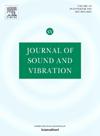Acoustic resonance excitation and source mapping in co-axial piping systems with different junction edge geometries
IF 4.3
2区 工程技术
Q1 ACOUSTICS
引用次数: 0
Abstract
In this study, the excitation of acoustic resonance in a coaxial piping system consisting of two opposite pipe branches is experimentally investigated. A lumped element model is used to determine the complex acoustic source, enabling the prediction of resonance excitation under specific flow conditions. The model is validated by assessing the susceptibility of two opposite side branches to acoustic resonance excitation. The predicted acoustic resonance parameters show good agreement with experimental observations in terms of the Strouhal numbers and normalized acoustic pressure amplitudes across a range of flow velocities. Additionally, the effects of rounding and chamfering the edges of the branching junction on resonance excitation are explored. Results indicate that rounded edges produce higher acoustic pressure amplitudes compared to chamfered and sharp edges, with a significant increase in Strouhal numbers at resonance. Furthermore, increasing the rounding radius raises both the onset flow velocity and the lock-in region. The influence of flow development and acoustic radiation losses on the excitation mechanism is also investigated. Findings show that side branches with fully developed flow and reduced acoustic radiation losses to the main pipe are more prone to acoustic resonance excitation and resonate at higher Strouhal numbers. However, the predicted acoustic amplitude reaches a maximum once the upstream distance allows for full flow development over the branching junction.
具有不同结边几何形状的同轴管道系统的声共振激发和源映射
本文对由两个相对分支组成的同轴管道系统的声共振激励进行了实验研究。采用集总元模型确定复杂声源,实现了特定流动条件下的共振激励预测。通过评估两个相对侧分支对声共振激励的敏感性来验证该模型。在一定流速范围内的斯特劳哈尔数和归一化声压幅值方面,预测的声共振参数与实验观测结果吻合良好。此外,还探讨了分支结边缘的圆角和倒角对共振激发的影响。结果表明,与倒角和锋利的边缘相比,圆形边缘产生更高的声压幅值,共振时的斯特罗哈尔数显著增加。此外,增大舍入半径会增加起动流速度和锁定区域。研究了流动发展和声辐射损失对激励机制的影响。研究结果表明,流动充分、声辐射损失较小的侧分支更容易发生声共振激发,且在较高的Strouhal数下产生共振。然而,一旦上游距离允许在分支连接处充分流动时,预测的声振幅达到最大值。
本文章由计算机程序翻译,如有差异,请以英文原文为准。
求助全文
约1分钟内获得全文
求助全文
来源期刊

Journal of Sound and Vibration
工程技术-工程:机械
CiteScore
9.10
自引率
10.60%
发文量
551
审稿时长
69 days
期刊介绍:
The Journal of Sound and Vibration (JSV) is an independent journal devoted to the prompt publication of original papers, both theoretical and experimental, that provide new information on any aspect of sound or vibration. There is an emphasis on fundamental work that has potential for practical application.
JSV was founded and operates on the premise that the subject of sound and vibration requires a journal that publishes papers of a high technical standard across the various subdisciplines, thus facilitating awareness of techniques and discoveries in one area that may be applicable in others.
 求助内容:
求助内容: 应助结果提醒方式:
应助结果提醒方式:


